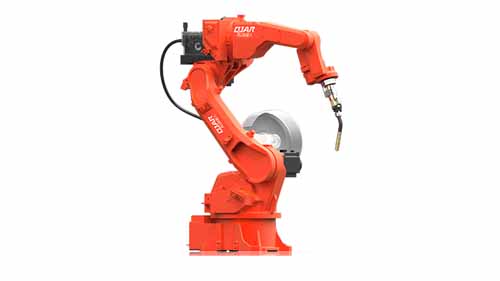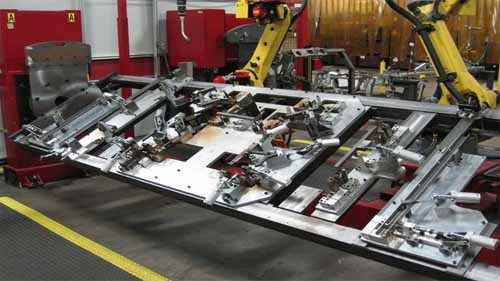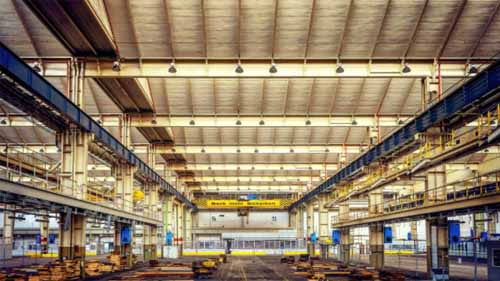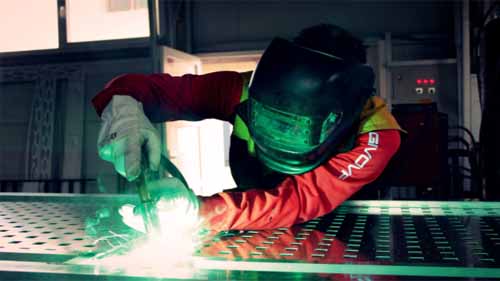
Welding is a very important phase of any form of advanced assembly. It is a process that ensures all the parts of a metallic product are joined together perfectly to increase the integrity of the said product. For this to work efficiently, there has to be a robotic welding cell set up. We are going to look at what a robotic welding cell is, how it works, where to buy it and the things you have to pay attention to when buying it.
What is a Robotic Welding Cell?

Source: Pinterest
A robotic welding cell, also called a welding unit, is a welding robot that is made up of several components that work together to weld metallic pieces together to create a complete structure. These components include the parts of the entire robotic arm that is involved in the welding alongside the welding accessories that are added to make the work much easier and more efficient.
The welding cell also comes with safety features that ensure the entire machine is safe for operation by humans, or they can be run safely when other machines are also operating nearby. Most manufacturers are in the habit of setting up a separate section for their automated welding processes since it takes up a lot of space for free movement. This may cost a little extra, but it is the right move to make because the last thing you want to have to deal with is machines bumping into each other.
Components of a Robotic Welding Cell
To better understand the function of a welding cell, it is important that we get to know each of the components that make up the entire machinery and the function that each of these components performs to ensure that welding is done the right way. The following are the components of a robotic welding cell.
Wire Feeder: This is a wire that is used to move the filler wire into the robot at a programmed pace for increased accuracy. The filler wire is also used to add some more material to a weld to make it stronger by fortifying the joint.
Welding Robot: This is the entire structure that makes up the main robot. It starts from the base all the way through the axles to the end effector. Welding robots are in two types; articulating and rectilinear. Each is designed to move in a different way and is used in different settings.
Wire Cleaner: This is a cleaner that is used to get rid of spatter from the torch every time the welding takes some breaks. This cleaning prolongs the lifespan of the welding equipment.
Torch: The torch is the part that makes use of electric power to fire up the electrode to join metals together. It is the part that shines brightly once it comes into contact with the metallic surface. They usually come with arc shielding parts that work alongside air or water to cool the entire machine down to avoid overheating, which may damage it.
Controller: This is the brain of the entire operation, the part that controls the welding cell. The robot controller is a small chip that contains the programming language that the welding cell executes. It can be reprogrammed and updated at any time.
Welding Power Supply: This supplies power to the welding torch, and they vary in size depending on the scale of the job and the size of the robotic welding arm. The power supplied also depends on the type of welding cell. It is much higher in arc welding compared to spot welding.
Stack Light: This is light that indicates what the welding cell is doing at any given time. If it lights up red, then that means an emergency stop has been initiated. Green means the cell is running smoothly, and orange indicates that the robot is being programmed.
Safety Features: These are emergency features that can be initiated in case an accident happens or is about to happen. Some of these features include an arc shield, access doors, fencing, and a host of other gears that can be used to stop the workers from inhaling unhealthy fumes or be exposed to bright light that could damage their eyes.
Robotic Welding Cell for Sale: Things to Consider
Robotic welding cells don’t come cheap, and finding the right robotic welding cell for sale can be a little challenging. Before you break your bank to acquire one, make sure you have done proper homework, including vetting the potential welding robot manufacturers you’ll buy from. There other things you need to pay attention to beforehand include the following.
The Type of Welding
There are different types of industrial welding robots, and each has its own way of operation that require different types of accessories. You have to figure out the type of welding that you want to do before thinking of the welding cell. This will help you figure out your budget and know the right equipment to go for. Going in blindly will cost you a fortune. The power consumption also varies depending on the type of welding, so factor that in as well.
The Space

Source: Pixabay
How much space do you have? A single welding cell requires a lot of space for the operations to be seamless. Imagine a car assembly plant for example. Each welding cell has to be large enough to accommodate a car with enough room for the car to be roasted in the air as the welding continues. You must have ample space on the manufacturing floor to pull this off.
Trained Staff

Source: Pixabay
Welding cells may be automated machines but they still require technical support that has to come in the form of qualified staff who not only know how to cooperate with them but how to do quick maintenance in the event that they come undone in the middle of an operation. They must possess the ability to make quick decisions because when a single welding cell stalls for even a single minute, the whole operation will have to be stopped, the initial, and that’s a huge loss that you may not be able to handle.
The Budget

Source: Pixabay
You must have sufficient funds to set up robotic welding systems in your manufacturing plant. Theintial cost will blow your head off, and for this reason, you must go in well prepared. On a positive note. Once you have set the cells up, you can rest easy knowing that they will serve you for a very long time to come. You also have to factor in the cost of the accessories needed to make the entire process seamless. Some welding cells cannot function on their own properly, and you may have to spend extra money getting the accompanying tools needed to barring the best out of them.
Conclusion
Welding is an intensive process that involves heavy machinery that has to be nimble and accurate. Getting these two combinations into a heavy machine like that is not easy but doable. Automated welding systems will increase production, cut down cycle times and give your products that are of uniform quality. If you run a manufacturing plant that requires welding cells, but you are lost on where to begin, pay our website a visit and learn how you can navigate around this.
